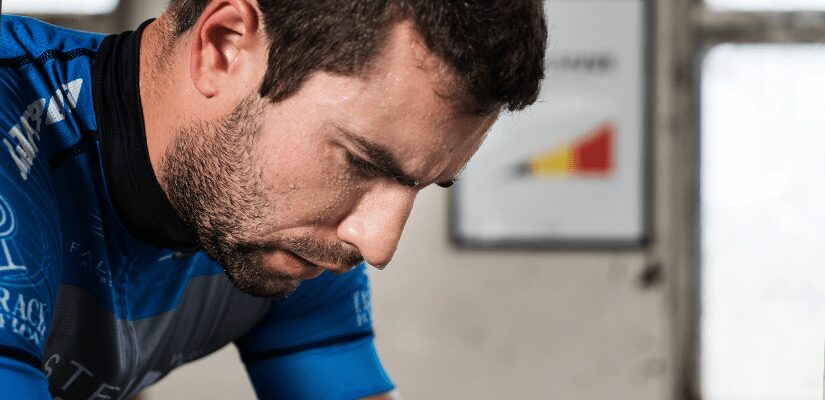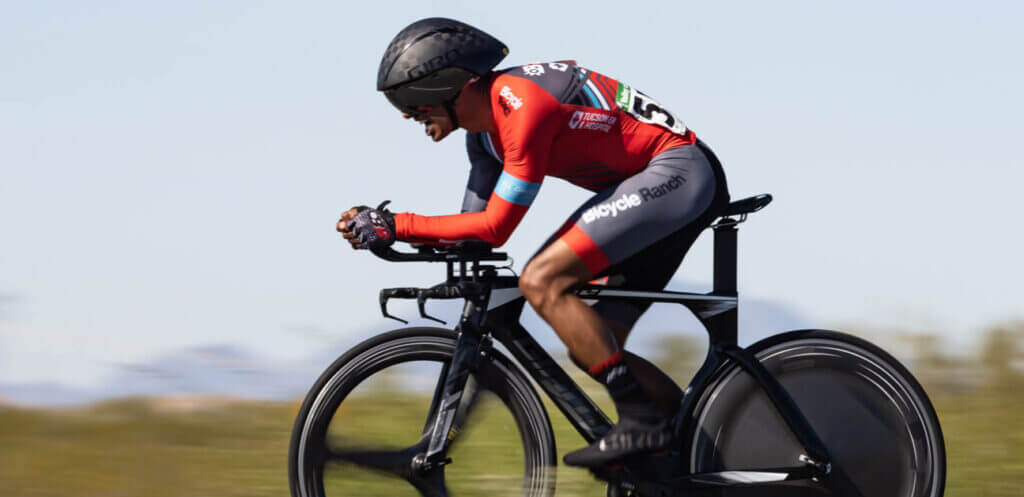kJ to Calories Conversion: How many calories do I burn cycling?

Answer: Divide the amount of kJs by 4.184 then divide by .25. Calories burned cycling are dependent on your Gross Metabolic Efficiency, but for most people, it’s between 20-25%. That means for every Calorie you burn produces around 1.045 kilojoules. For practical reasons, most cyclists approximate 1 kJ is equal to 1 Calorie.
In the context of cycling, energy, how it’s consumed, burned and expended is at the center of endurance performance. Energy in cycling refers to a couple things: the energy that is stored in the form of chemical energy from nutrition, and the heat and mechanical energy that’s doled out when we’re on the bike. Let’s cover a few of the different terms we have for that energy.
What is a Calorie?
First thing’s first — what is a calorie? In order to perform while cycling, we need energy. Simply put, a calorie is a unit of that energy and is most commonly thought of in two ways: the small calorie (often referred to as the gram/physics calorie) and the large Calorie (known as the dietary calorie, often indicated by a capital “C”).
- The small calorie is most often used in chemistry, as it represents the approximate amount of energy required to increase the temperature of one gram of water by one degree celsius.
- The dietary Calorie is what you’re used to seeing. We consume food as a source of energy and the Calorie is simply a measure of stored chemical energy from the food we ingest. That chemical energy transfers into heat and mechanical energy for work in the body.
Adaptive Training
Get the right workout, every time with training that adapts to you.
Check Out TrainerRoadWhy is this important?
Because 1 dietary Calorie = 1000 physics calories. This explains why Calories are often referred to as kilocalories (kcals), because kilo means “thousands”. So when you say “I burned 500 calories today”, you’re really saying that you burnt 500 kilocalories (dietary Calories) or 500,000 physics calories.
What is a Kilojoule?
The International System of Units (SI) deems the ‘joule’ to be the standard base unit to quantify energy, work and heat. So although Calories/calories are on the metric system, they have been superseded by the SI standard of the joule. So we think of Calories as a measure of the potential energy stored in food to be burned in our body, and joules as the measure of work done while cycling. This means it’s useful to know their conversion:
1 calorie (the small calorie) = 4.184 joules
Now, knowing the difference between Calories and calories, one can assume that we’ll need to express joules in a form that converts to the Calorie.
1000 calories = 1 Calorie (dietary)
1,000 joules = 1 kilojoule (kJ)
1 calorie = 4.184 joules → 1 Calorie = 4.184 kJs
How does One Calorie Equal One Kilojoule?
Even though we just showed that 1 Calorie is 4.184 kJs, the body is not 100% efficient at using that Calorie. The body’s efficiency of turning fuel combustion into work is called an individual’s Gross Metabolic Efficiency (GME). The typical GME ranges from roughly 20% to 25%. What that means is, of the 1 Calorie your body plans to burn to produce 4.184 kJ of work, the average human body is only going to be effectively using 20-25% of that Calorie to do so. The remaining 75-80% of the stored chemical energy (Calories) is lost to the external environment in the form of heat.
This boils down to a 1:1 ratio as you can see below:
1 Calorie × 25% = .25 → .25 × 4.184 kJ = 1.045 kJ
For practical reasons, most cyclists approximate this to: 1 kJ to 1 Calorie.
In order to give riders an idea of their kJ/Calorie reading, the TrainerRoad workout page gives users the ability to see just how many kJ/Cal they can expect to output/burn on any given workout.
Ways to Measure Calories Burned While Cycling
It takes a gas exchange lab test to pin down exactly what percentage your GME is, so a majority of people use the approximation of 25% to keep things simple with the kJ-to-Calorie conversion. To help avoid the hassle of getting your precise GME, there are devices to give you precise Calorie calculations — some better than others:
Power
Power devices give us the ability to see how many kJ’s were outputted in a particular workout session. To brush on some old physics definitions, a joule is defined as watts x seconds. A kilojoule being 1000 x that number. Therefore, there really isn’t a more objective and precise tool to determine a kJ output, and subsequently an estimate of Calories burned. In fact, most agree that it’s within 5% accuracy when calculating Calories burned.
Using what we’ve just learned above, we can firmly make the following statement: The approximate 1:1 ratio of kJ to dietary Calories can be relied on far more when using a device that directly measures power, since we have an objective measure of kJs outputted.
Heart Rate
Calorie calculations based on Heart Rate have improved over the last decade or so, but the accuracy is still somewhere in the neighborhood of 10-20%. Even when HR is coupled with an individual rider’s specifics (age, weight, gender, height), the algorithms can still fail to account for things like: different stroke volume, different max HR’s, and different levels of output at different percentages of HR from rider to rider. Some methods that include VO2 max have been able to close this gap slightly, but again, determining VO2 max is another lab test out of the reach of many.
Before understanding why Calorie calculations are variably less reliable with Heart Rate than they are with Power, we need to drive home the following point: stress vs. strain. When the body applies forces to the pedals you produce stress; strain however is the response to that applied stress. Power objectively measures what you did on the bike (stress) and Heart Rate measures how your body reacted to that stress (strain). Heart Rate should be used to inform you how your body is reacting to the stress you’re applying to it.
Having said that, Heart Rate can still be useful in determining Calorie calculations, but it’s clear why a Caloric measurement is best estimated by a direct measure of kJ rather than using an algorithm in combination with HR readings. As technology advances, so has the ability to get closer to the precision of Caloric calculations from Power, but we’re still not there yet.
Going from kJs to Calories — The Math
Say you get done with a workout and your power meter reads you had a 1500kJ ride. How can we approximate Calories burned going from kJ to Calories? We’ll simply divide the total kJ by 4.184, then factor in the efficiency. See below:
1500 ÷ 4.184 = 358.51
A rider’s GME is now factored in:
358.51 ÷ 25% → 358.51 ÷ .25 = 1434.03
For a rider with a GME of 25%, it took 1434.03 Calories (kcals) to output 1500 kJ.
Let’s see what it would be if we were on the lower end of the 20-25% GME:
1500 ÷ 4.184 = 358.51
358.51 ÷ 20% → 358.51 ÷ .20 = 1792.55
For a rider with a GME of 20%, it took 1792.55 Calories to output 1500 kJ
Using kJs to Plan Your Cycling Nutrition
If you have a cycling event, you can plan both the pacing and nutrition. Once you have a power target, you can estimate your energy expenditure in kJs. Finding your energy expenditure in kilojoules (kJs) is simple. Just multiply your planned average wattage by total time in seconds, then divide by 1000. You can estimate your total time to get an approximate number to shoot for.
For example, if you are doing a 3 hour ride and plan to average 216w, then 216w x 10,800 (3 hours in seconds) ÷ 1000 is 2,332kJs. Since a kJ is roughly equivalent to a Calorie, you can decide how you are going to fuel your ride.
If you are tracking how many calories you burn while cycling for weight loss, check out How to Lose Weight Through Cycling.
For more cycling training knowledge, listen to Ask a Cycling Coach — the only podcast dedicated to making you a faster cyclist. New episodes are released weekly.
